 Index
Index

Sucrose, also called saccharose, is ordinary table sugar refined from sugar cane or sugar beets. It is the main ingredient in turbinado sugar, evaporated or dried cane juice, brown sugar, and confectioner's sugar. Lactose has a molecular structure consisting of galactose and glucose. It is of interest because it is associated with lactose intolerance which is the intestinal distress caused by a deficiency of lactase, an intestinal enzyme needed to absorb and digest lactose in milk. Undigested lactose ferments in the colon and causes abdominal pain, bloating, gas, and diarrhea. Yogurt does not cause these problems because lactose is consumed by the bacteria that transform milk into yogurt.
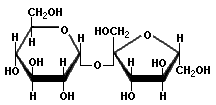
| Disaccharide | Description | Component monosaccharides |
|---|---|---|
| sucrose | common table sugar | glucose 1α→2 fructose |
| maltose | product of starch hydrolysis | glucose 1α→4 glucose |
| trehalose | found in fungi | glucose 1α→1 glucose |
| lactose | main sugar in milk | galactose 1β→4 glucose |
| melibiose | found in legumes | galactose 1α→6 glucose |
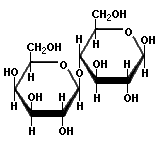
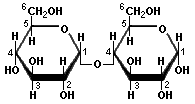
Maltose consists of two α-D-glucose molecules with the alpha bond at carbon 1 of one molecule attached to the oxygen at carbon 4 of the second molecule. This is called a 1α→4 glycosidic linkage. Trehalose has two α-D-glucose molecules connected through carbon number one in a 1α→1 linkage. Cellobiose is a disaccharide consisting of two β-D-glucose molecules that have a 1β→4 linkage as in cellulose. Cellobiose has no taste, whereas maltose and trehalose are about one-third as sweet as sucrose.
Raffinose, also called melitose, is a trisaccharide that is widely found in legumes and cruciferous vegetables, including beans, peas, cabbage, brussels sprouts, and broccoli. It consists of galactose connected to sucrose via a 1α→6 glycosidic linkage. Humans cannot digest saccharides with this linkage and the saccharides are fermented in the large intestine by gas-producing bacteria. Tablets containing the enzyme alpha-galactosidase, such as Beano, are frequently used as digestive aids to prevent gas and bloating. The enzyme is derived from selected strains of the food grade fungus Aspergillus niger.
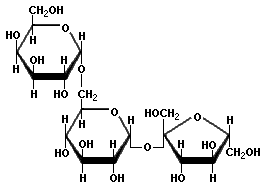
Many polysaccharides, unlike sugars, are insoluble in water. Dietary fiber includes polysaccharides and oligosaccharides that are resistant to digestion and absorption in the human small intestine but which are completely or partially fermented by microorganisms in the large intestine. The polysaccharides described below play important roles in nutrition, biology, or food preparation.
Starch is the major form of stored carbohydrate in plants. Starch is composed of a mixture of two substances: amylose, an essentially linear polysaccharide, and amylopectin, a highly branched polysaccharide. Both forms of starch are polymers of α-D-Glucose. Natural starches contain 10-20% amylose and 80-90% amylopectin. Amylose forms a colloidal dispersion in hot water (which helps to thicken gravies) whereas amylopectin is completely insoluble.

|
| Amylose |
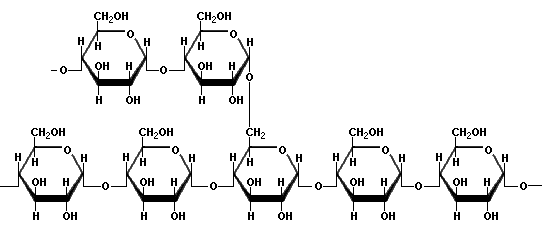
|
| Amylopectin |

|
| The side branching chains are clustered together within the amylopectin molecule |
Starches are transformed into many commercial products by hydrolysis using acids or enzymes as catalysts. Hydrolysis is a chemical reaction in which water is used to break long polysaccharide chains into smaller chains or into simple carbohydrates. The resulting products are assigned a Dextrose Equivalent (DE) value which is related to the degree of hydrolysis. A DE value of 100 corresponds to completely hydrolyzed starch, which is pure glucose (dextrose). Dextrins are a group of low-molecular-weight carbohydrates produced by the hydrolysis of starch. Dextrins are mixtures of polymers of D-glucose units linked by 1α→4 or 1α→6 glycosidic bonds. Maltodextrin is partially hydrolyzed starch that is not sweet and has a DE value less than 20. Syrups, such as corn syrup made from corn starch, have DE values from 20 to 91. Commercial dextrose has DE values from 92 to 99. Corn syrup solids, which may be labeled as soluble corn fiber or resistant maltodextrin, are mildly sweet semi-crystalline or powdery amorphous products with DEs from 20 to 36 made by drying corn syrup in a vacuum or in spray driers. Resistant maltodextrin or soluble corn fiber are not broken down in the digestive system, but they are partially fermented by colonic bacteria thus providing only 2 Calories per gram instead of the 4 Calories per gram in corn syrup. High Fructose Corn Syrup (HFCS), commonly used to sweeten soft drinks, is made by treating corn syrup with enzymes to convert a portion of the glucose into fructose. Commercial HFCS contains from 42% to 55% fructose, with the remaining percentage being mainly glucose. There is an effort underway to rename High Fructose Corn Syrup as Corn Sugar because of the negative public perception that HFCS contributes to obesity. Modified starch is starch that has been changed by mechanical processes or chemical treatments to stabilize starch gels made with hot water. Without modification, gelled starch-water mixtures lose viscosity or become rubbery after a few hours. Hydrogenated glucose syrup (HGS) is produced by hydrolyzing starch, and then hydrogenating the resulting syrup to produce sugar alcohols like maltitol and sorbitol, along with hydrogenated oligo- and polysaccharides. Polydextrose (poly-D-glucose) is a synthetic, highly-branched polymer with many types of glycosidic linkages created by heating dextrose with an acid catalyst and purifying the resulting water-soluble polymer. Polydextrose is used as a bulking agent because it is tasteless and is similar to fiber in terms of its resistance to digestion. The name resistant starch is applied to dietary starch that is not degraded in the stomach and small intestine, but is fermented by microflora in the large intestine.
| fructose | 173 |
| invert sugar* | 120 |
| HFCS (42% fructose) | 120 |
| sucrose | 100 |
| xylitol | 100 |
| tagatose | 92 |
| glucose | 74 |
| high-DE corn syrup | 70 |
| sorbitol | 55 |
| mannitol | 50 |
| trehalose | 45 |
| regular corn syrup | 40 |
| galactose | 32 |
| maltose | 32 |
| lactose | 15 |
Glucose is stored as glycogen in animal tissues by the process of glycogenesis. When glucose cannot be stored as glycogen or used immediately for energy, it is converted to fat. Glycogen is a polymer of α-D-Glucose identical to amylopectin, but the branches in glycogen tend to be shorter (about 13 glucose units) and more frequent. The glucose chains are organized globularly like branches of a tree originating from a pair of molecules of glycogenin, a protein with a molecular weight of 38,000 that acts as a primer at the core of the structure. Glycogen is easily converted back to glucose to provide energy.
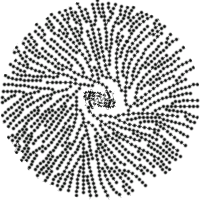
|
| Glycogen |
Dextran is a polysaccharide similar to amylopectin, but the main chains are formed by 1α→6 glycosidic linkages and the side branches are attached by 1α→3 or 1α→4 linkages. Dextran is an oral bacterial product that adheres to the teeth, creating a film called plaque. It is also used commercially in confections, in lacquers, as food additives, and as plasma volume expanders.
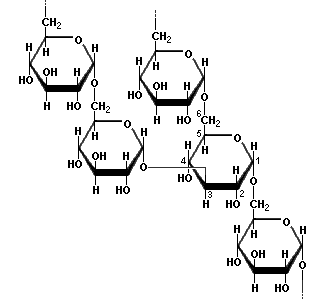
|
| Dextran |
Some plants store carbohydrates in the form of inulin as an alternative, or in addition, to starch. Inulins are present in many vegetables and fruits, including onions, leeks, garlic, bananas, asparagus, chicory, and Jerusalem artichokes. Inulins, also called fructans, are polymers consisting of fructose units that typically have a terminal glucose. Oligofructose has the same structure as inulin, but the chains consist of 10 or fewer fructose units. Oligofructose has approximately 30 to 50 percent of the sweetness of table sugar. Inulin is less soluble than oligofructose and has a smooth creamy texture that provides a fat-like mouthfeel. Inulin and oligofructose are nondigestible by human intestinal enzymes, but they are totally fermented by colonic microflora. The short-chain fatty acids and lactate produced by fermentation contribute 1.5 kcal per gram of inulin or oligofructose. Inulin and oligofructose are used to replace fat or sugar and reduce the calories of foods like ice cream, dairy products, confections and baked goods.
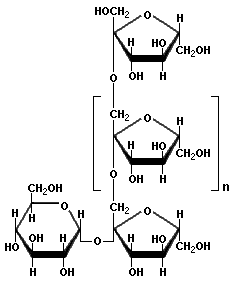
|
| Inulin n = approx. 35 |